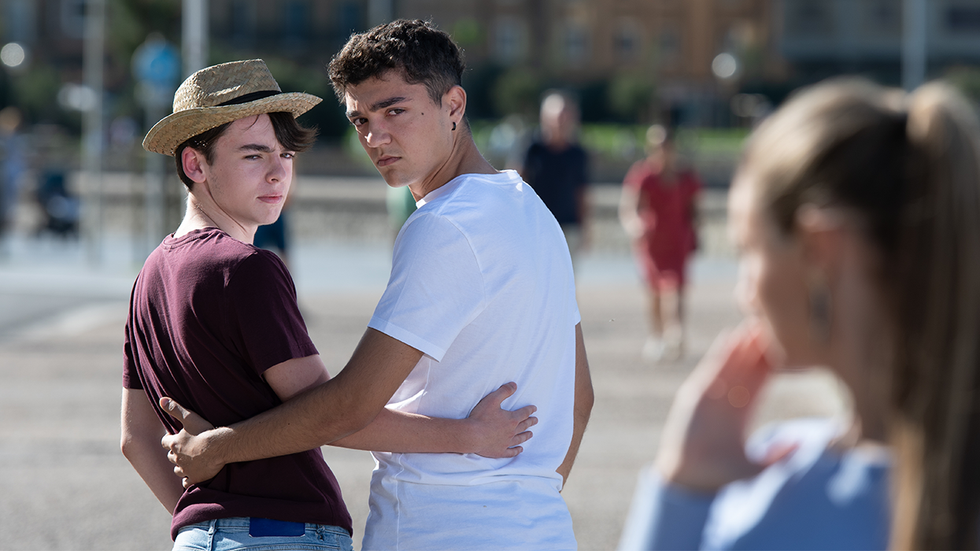
WWW.OUT.COM
What is loud looking, and why do Gen Z queers keep calling it out?
Youre vibing at an event in mirrored shades, mesh, and whatever else makes you feel sexy. Someone across the street freezes, jaw open, phone half-raised. On TikTok, a trans makeup artist posts a GRWM, and the comments flood with I cant stop staring! Whether offline or on-screen, these lingering, wide-eyed reactions all carry the same energy: loud looking.The term has exploded on queer social media over the past year, giving a name to that invasive, spectacle-style stare. Think of it as the moment admiration tilts into objectification. The difference between You look amazing! and a six-second video captioned Spotted this at Walmart. According to Tinders 2024 Year in Swipe report, transparency and permission are now the hottest dating trends. 70 percent of singles want a serious connection, while nearly half explicitly state their dating goals in their bios. In other words, Gen Z is over ambiguity. The same clarity applies to how we look at one another.So what is loud looking, exactly? PRIDE talked to Adam Cohen-Aslatei, CEO of the matchmaking firm Three Day Rule, to get to the bottom of it.What is loud looking?Loud looking refers to the kind of attention queer people may receive when they are watched or stared at in ways that feel obvious, invasive, or disrespectfulas if they are on display for entertainment, says Cohen-Aslatei. It can reduce real, lived identities to spectacle, turning authenticity into something to be consumed rather than respected.Unlike a quick glance of appreciation, loud looking lingers. It often includes raised eyebrows, whispered commentary, or furtive phone cameras. The vibe is less fabulous and more human safari.Where did the term come from?Cohen-Aslatei notes that the phrase is a more academic term coined by social psychologists who study how we look at each other, especially when it comes to people who are different, niche groups, and marginalized minorities.For decades, scholars have analyzed the male gaze and female gaze. In queer circles, writers like bell hooks and Jos Esteban Muoz unpacked how marginalized people are both hypervisible and invisible at the same time. Loud looking is the TikTok-ready evolutionsuccinct, meme-able, and perfect for calling out creepers in the comments.Visibility, desire & the queer gazeQueer style has always been about visibility. Think leather at Stonewall, voguing in Harlem ballrooms, and gender-bending streetwear in 2025. But Cohen-Aslatei says loud looking flips the shame script.Loud looking shifts the focus of shamenot onto the queer person being observed, but onto the act of looking itself, he says. It frames the one doing the staring as potentially inappropriate, especially when that gaze feels judgmental, excessive, or invasive.He distinguishes this gaze from objectification. Objectification happens when a person is reduced to a body part, a stereotype, or a fantasy, he explains. Loud looking, on the other hand, is when someone watches queer peopleespecially those who are visibly expressive or non-normativein a way that feels intrusive, exaggerated, or loaded with judgment or fascination. Drag brunch tourists who gasp I cant believe what Im seeing are a textbook example.Safety, surveillance, and social mediaLoud looking isnt just awkwardit can be dangerous. Trans and femme-presenting individuals often face heightened judgment and subtle surveillance simply for being seen, Cohen-Aslatei warns. From bathroom harassment to viral videos posted without consent, the gaze can escalate into real-world harm.Online, the risk multiplies. Apps like TikTok and Instagram give queer people powerful tools to express themselves, he says. But even content meant for a supportive audience can land in front of viewers who dont understand or respond respectfully. The 2024 Green Flags Study from Tinder underscores this assumptions epidemic. Daters consistently misread each others intentions, projecting stereotypes before a single DM is exchanged. Swap romantic intentions for gender expression, and you get the same noisy misunderstanding, only now in the form of stares, stitches, and side-eye.Why Gen Z owns the clap-backCohen-Aslatei sees a generational split. What one generation sees as empowerment, another may perceive as risk, he says. Older queer folks who survived the AIDS crisis often mastered the art of flying under the radar. Gen Z, raised amid rainbow-emoji marketing and endless selfie culture, leans the other way: be seen, and call out anyone who makes that visibility unsafe.On TikTok, the tag #loudlooking sits alongside #thisismaface for trans joy and #bigenderfashionhauls. Posts pair quick-cut reaction memes with sassy captions that imply the gawking is not only noticed but named. How to look without becoming loudCohen-Aslatei reminds us that looking is a natural human behavior, but it crosses the line when curiosity morphs into surveillance, spectacle, or subtle domination. Heres a cheat sheet:Read the room. Is your glance longer than a second or two? Dial it back.Compliment, dont comment. A sincere Love your boots! beats a whispered Wow, thats a guy? every time.Ask before you film. If you wouldnt covertly record a brides wedding dress, dont record a strangers Pride outfit either.Mirror energy. If someone looks comfy and open, a smile may be welcome. If they seem tense or avoidant, respect that boundary.Reflect inward. Are you staring because youre inspiredor because youre shocked? One builds community; the other turns people into props.The bigger pictureLoud looking captures the double-edged sword of queer visibility in 2025: freedom to express, paired with a fresh wave of public scrutiny. As Cohen-Aslatei puts it, Modern loud lookers dont just starethey film, post, and comment in real time.Yet naming the behavior is power in itself. If queer style is a language, loud looking is the grammar rule that says, Observe, dont objectify. When in doubt, offer a nod of solidarity instead of a running commentary. We all deserve the freedom to strut down the streetor the timelinewithout being treated like the days entertainment.So the next time a sequined stranger turns heads, remember: Theres a difference between looking and looking loudly. Choose the quiet appreciation, and let them slay in peace.
0 Comments
0 Shares
103 Views
0 Reviews



